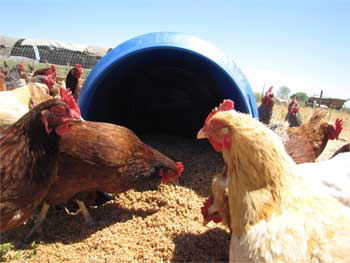Mixed or single enzymes for non-starch carbohydrates?

In a blog entry on WorldPoultry.net earlier this year I discussed the important topic of selecting the appropriate enzyme when it comes to non-starch carbohydrates (xylans, ß-glucans, and xyloglucans). This sparked a lively debate among the readers of the blog, each supporting one of two schools of thought.
By Ioannis Mavromichalis, International consulting nutritionist, Ariston Nutrition SL, Spain
To begin with, it appears that there is sufficient general consensus that poultry is the species likely to benefit the most from the use of exogenous carbohydrases. This is due to the fact that poultry have a rather short intestinal system that does not provide for enough digestion time, as is the case for pigs. Coupled with rapid feed passage, caused in part from the high feed intake patterns in modern hybrids, it becomes apparent that poultry (and especially broilers) would provide the best returnon- investment when it comes to these enzymes. Here, it should be noted, that the short market life of broilers makes them ideal subjects for rapid and low(er) cost research, which in turn has enabled enzyme companies to register a larger number of poultry applications compared to pigs.
It is also important to note that this discussion is about carbohydrases that digest carbohydrates other than starch (non-starch carbohydrates, NSC), and as such it excludes amylases. Thus, such carbohydrates include xylans (abound in wheat) and β –glucans (abound in barley) that are present in all cereals in varying concentrations. The benefits from the use of xylanases and β -glucanases are due to reduced digesta viscosity, and increased nutrient – mainly energy – digestibility. There are several scientific reports on this topic, and the majority of them rather support this notion.
The effects of such enzymes would naturally depend on the concentration of these NSCs in cereals, with little or no benefit seen in varieties with very low concentration in these anti-nutritional factors. Nevertheless, there are two factors that have made the use of enzymes very important in recent times:
- The increased number of poultry operations that receive mixed loads of cereals from a variety of sources – making it impossible to monitor the levels of xylans and β-glucans and,
- The continuously increasing price of all cereals that have placed a strain on feed costs – therefore making enymes more attractive from a costbenefit point of view.
Schools of thought
Today, there are two schools of thought regarding the selection of the right carbohydrase to use in cereal based diets, especially those based heavily on wheat and(or) barley; the latter along with maize in most cases.
Some authorities recommend using only a xylanase if the diet is based on wheat, or a β -glucanase if wheat is absent and the diet contains high levels of barley. This ensures that the targeted NSC that abounds in the cereal present in each diet is attacked and digested with the greatest efficacy, yielding potentially the greatest benefit. This strategy appears to work best when diet composition remains relatively fixed or when feeds are mixed using all single ingredients (instead of using concentrates, premixes, etc.) On the other hand, there is a growing number of authorities arguing that although wheat is predominantly rich in xylans (and barley in β -glucans), nevertheless, all cereals contain varying levels of all NSCs. This is true even in the case of maize. As such, a cocktail of xylanase and β -glucanase could be more effective, especially if the cost of the enzymes per tonne of complete feed is about the same in both strategies (single versus cocktail). Here, the use of cocktails or tailored combinations would provide logistical benefits in diets with frequent formulation changes and (or) in the use of premixed concentrates.
Clearly, there is no quick and easy answer to the above dilemma (one enzyme or mix of enzymes), especially as there are no independent research reports that would help shed light on this very interesting question.
Xylose concern and mixed diets
As part of the blog discussion, some interesting points have been made concerning the use of an exo-xylanase enzyme. This enzyme clips from the end of the xylan chain yielding xylose molecules that are readily absorbed by the animal. As xylose has no value for the animal, it needs to be excreted, creating thus a potential metabolic stress. This becomes rather important if the levels of absorbed xylose are substantially high enough – something that requires quantification. Moreover, it has been suggested that endo-xylanases should be preferred, but again this remains a theory.
One concern among commercial nutritionists is the ever-changing composition of diets based on the principle of least-cost formulation. One week, diets may be high in wheat, the next week it could contain a mix of wheat and barley, whereas the third week could be without wheat, but still contain some barley. Or, as is often the case in certain regions, a diet with all three major cereals is constantly in use, although exact concentrations may vary depending on prices. In these cases, it is difficult to decide whether a cocktail, a tailor made combination, or single enzyme should be used, especially if this additive forms part of a pre-mixed concentrate that is used to prepare the final diets.
Maize and soya
To add to the above questions, today, there is no clear answer in regards to the use of these enzymes in diets based solely on maize and soya. Although both ingredients contain enough NSCs to warrant concern over their impact, research has not been so clear-cut as in the case of wheat and barley (or it has been rather more confusing!) Some authorities argue that diets based solely or heavily on these two common ingredients do not benefit from the use of xylanases or β -glucanases. However, there is a growing number of enzyme manufacturers who believe that there are certain enzymes that could potentially change the way we think about NSCs in maize and soya. This remains to be seen and will certainly be the topic of a next blog entry, open for discussion!
Perhaps, the ideal solution would be to have mixed products, but with a predominant carbohydrase, targeting the major cereal in each diet. Thus, a xylanase- heavy cocktail (that contains also lower levels of β -glucanase) would be used in diets rich in wheat, whereas the opposite would be preferable in the case of barley-rich diets. This approach, however, might be more expensive than using a single enzyme product, especially if a second enzyme has no real effect on nutrient digestibility! It also does not solve any of the feed mixing logistic problems mentioned above.
Clearly, there are more questions than answers here, and if anything, this article is about raising these questions rather than providing the answers. Research is urgently required to identify the correct approach in the use of these enzymes that have sparked such lively interest lately.
[Source: Enzyme special]











